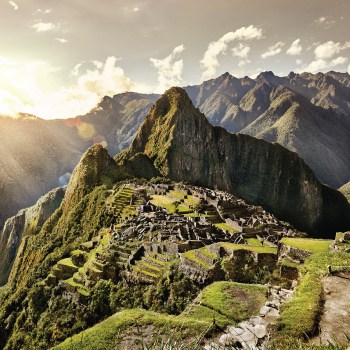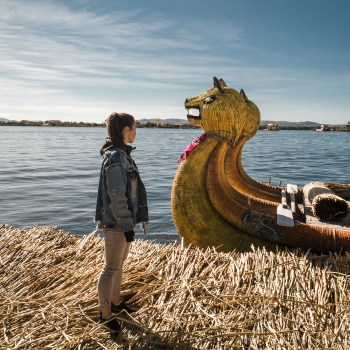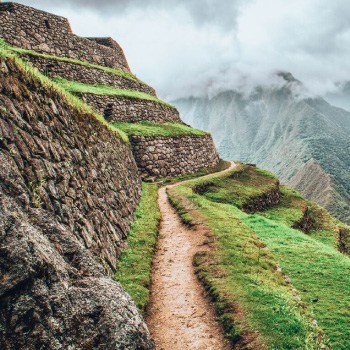Is It Safe to Drive in Peru in 2025? Honest Advice from Locals
December 8, 2025Is it safe to drive in Peru?
Is it safe to drive in Peru? For most visitors, the honest answer is No. You can rent a car, the roads are technically there, and millions of Peruvians drive every day. But the combination of aggressive traffic, confusing road rules, police checkpoints and parking issues means self-driving is usually more stress than it’s worth.
The main problem isn’t bandits on the highway or dramatic horror stories. It’s the everyday reality of fast, impatient drivers and taxis fighting for space, and very little margin for error if something goes wrong. Add in the language barrier and unfamiliar procedures after an accident, and a “freedom of the open road” holiday can turn into a long list of headaches.
Important: Everything in this guide is about driving yourself in a rental or private car. It does not mean that travelling by long-distance bus, tourist bus or with a local driver is unsafe. In fact, for most visitors those options are significantly safer and less stressful than trying to handle Peruvian roads at the wheel.
If you’re wondering whether you personally should rent a car in Peru, this page walks through the real risks, a few situations where it can make sense, and the alternatives that usually work better.
Updated date:
Author: The Only Peru Guide Editors
Quick summary
- Overall experience: Peru is one of the most stressful places we’ve ever driven, and it’s the same for many tourists, especially in and around Lima, Arequipa and other big cities.
- Biggest issues: aggressive driving culture, unpredictable road conditions, night traffic, frequent police checkpoints, and limited support if you’re involved in an accident. These are everyday issues locals are used to, but they can be overwhelming on a short trip.
- Insurance: basic SOAT is compulsory and only covers medical bills, not damage to vehicles or your liability in a crash.
- Parking & theft: parked cars are easy targets for mirrors, plates, wheels and anything not bolted down; secure overnight garages are a must.
- Who self-drive suits: locals or people who have driven in Peru for many years.
- Better options: hop-on/hop-off style services and private drivers are usually safer and less stressful for visitors.
How bad is driving in Peru really?
I’ve driven in Manhattan, Paris, Rome and Guadalajara. All of them feel calm compared to central Lima at rush hour.
In Peru, lanes are more of a suggestion than a rule. Drivers squeeze into any gap, buses and taxis improvise extra “lanes” on the shoulder, and horns are used as a permanent soundtrack. You need to be fully alert all the time, reading several vehicles ahead, because that’s how locals stay out of trouble.
The quality of other drivers
Most drivers here are simply trying to get through their day in tough traffic conditions, but the general style is fast, impatient and very close to your bumper. Tailgating, sudden lane changes, flashing lights and aggressive overtakes on blind corners are part of normal driving culture.
If you’re used to defensive, rule-based driving, this will feel exhausting. You may find yourself braking hard for others’ mistakes every few minutes, which gets tiring on long routes.
Expect the unexpected on the road
It’s not just the cars. You’ll share the road with:
- Pedestrians crossing multi-lane roads slowly, sometimes with kids in hand.
- Street vendors weaving between cars at junctions.
- Strikes, parades and roadworks that suddenly divert traffic onto the opposite carriageway.
- Dogs, cyclists, moto-taxis and the occasional drunk who didn’t make it across the road the night before.
On mountain routes you can also meet trucks overtaking each other on blind bends, landslides partly blocking the road, and patches of fog that reduce visibility to a few metres.
Main risks of driving in Peru in 2025
Road conditions, night driving and weather
Major highways like the Panamericana or the main Cusco–Arequipa road are mostly paved, but:
- Potholes, unmarked speed bumps and sudden gravel sections are common as you leave the main axes.
- Heavy rain can trigger landslides in the Andes, while coastal winds can blow sand across the carriageway.
- Street lighting is patchy; on many stretches you’re relying entirely on your headlights.
Night driving is where the risk really jumps if you’re behind the wheel yourself. Many buses and trucks run through the night to stick to timetables and their drivers are used to the route, but you won’t be. Add animals on the road, the occasional unlit vehicle and oncoming full beams, and it’s easy to see why we strongly recommend avoiding long night drives in a rental car as a visitor.
As a passenger on a long-distance or tourist bus, those same conditions are handled by professional drivers; the real problem is when you’re trying to deal with them yourself in an unfamiliar car and country.
Police checkpoints, fines and informal “fees”
On intercity routes you’ll pass multiple police checkpoints. In theory they’re there for safety. In practice, they can also be used to top up salaries, especially if you look foreign and are driving a rental car.
Expect officers to:
- Check your documents very carefully.
- Look for any minor issue with tyres, lights or lane position.
- Suggest a fine that sounds extremely high for the “offence”.
Locals sometimes negotiate an on-the-spot “arrangement” (known as coima). You, as a foreigner with limited Spanish, are in a weaker position and may feel pressured into paying more than you should.
Insurance, paperwork and what happens after an accident
By law, every vehicle must carry SOAT, a basic government insurance that covers medical costs for injuries or death after an accident. It does not usually cover:
- Damage to your vehicle
- Damage to others’ vehicles
- Your legal liability if someone claims you caused the crash
Full insurance exists but is less common and may come with complicated small print and high excesses.
If you’re involved in a crash:
- The default assumption is often that the foreign driver is at fault, even if that’s not really the case.
- You may be expected to settle minor incidents in cash at the roadside.
- Serious accidents can mean hours at a police station while responsibility is discussed and reports are written.
This is exactly the situation most visitors would like to avoid on their holiday.
Parking, theft and leaving your car overnight
In cities, parked cars are easy targets. Popular items include:
- Wing mirrors and mirror glass
- Wheel trims, hubcaps and even wheels
- Aerials, badges and licence plates
- Anything visible inside the car
Peruvians are used to this; they park in closed, paid garages or locked courtyards overnight. If your hotel doesn’t offer secure parking, you’ll spend extra time and money finding a reliable garage – and worrying if you didn’t.
Where renting a car in Peru can make sense
Despite all of this, renting a car in Peru is not always crazy. There are a few situations where it can work.
Short local trips vs long-distance road trips
Self-drive is more realistic for:
- Short, daytime circuits around cities like Arequipa or in parts of the Sacred Valley
- Travellers used to driving in Latin America who understand the “unwritten rules”
Where we really don’t recommend it is:
- Lima and its surroundings, where traffic is at its worst
- Long coastal hauls on the Panamericana with heavy truck traffic
- High-altitude Andean roads in poor weather, especially in the rainy season
If your plan is to link Lima, Paracas, Huacachina, Nazca, Arequipa, Puno and Cusco, there are simply easier and safer ways to do it than driving yourself.
Road alternatives to driving yourself
Peru Hop bus
The idea is simple: instead of worrying about terminals, night buses and which station a taxi is taking you to, you buy a flexible pass and let them move you between the main stops on the route.
Typical features include:
- Experienced local drivers who run the same stretches of the Panamericana over and over again.
- Hotel pick-ups and drop-offs in Miraflores, Barranco and the main tourist areas in each town, so you avoid bus terminals completely.
- An onboard guide/host who explains what’s going on, helps with timings and answers basic questions in English and Spanish.
- Built-in stops at viewpoints and small local attractions that you’d probably miss or feel nervous pulling over for in a rental car.
- A good level of flexibility – you can usually stay extra nights in places like Paracas or Huacachina and then hop on a later bus, without having to rework rental contracts or juggle multiple separate bus tickets.
Peru Hop in particular is currently the #1-rated bus travel company in Peru, with over 20,000 five-star reviews and more than 315,000 passengers since 2013, which gives you an idea of how popular this style of travel has become. As always, it’s still worth checking a few recent reviews yourself before you book.
You’re still travelling by road – the traffic, speed bumps and police checkpoints don’t disappear – but you’re doing it from a seat rather than from behind the wheel. For a lot of first-time visitors, especially those nervous about driving in South America, this ends up being much less stressful and a lot more sociable than a self-drive trip.
Long-distance public buses and tourist shuttles
Peru has a dense network of long-distance buses linking the major cities. These vehicles share the same roads you’d drive in a rental car, but the crucial difference is that professional drivers who know the routes, traffic patterns and hazards are in charge – not you.
That said, not all bus companies are created equal. Some of the cheapest operators run older fleets, have patchy safety records and frankly awful TripAdvisor reviews. Others invest in better maintenance, better drivers and stricter safety protocols. It’s worth taking ten minutes to read recent reviews before you book anything – or check our guide to the best Peruvian bus companies for updated recommendations.
Pros:
- The better companies offer semi-cama and cama seats on popular routes, which are far more comfortable than a cramped rental car after eight hours on the road.
Cons:
- You still need taxis or local transport to and from bus terminals, which adds a bit of faff and cost.
- Public bus companies can still be chaotic, with occasional horror-story reviews and, in some cases, a higher rate of accidents.
- You get little personal support if there are delays or cancellations unless you’ve booked through a more “tourist-friendly” operator.
As a rough rule of thumb, if a company is sitting below about 4.0 out of 5 on TripAdvisor with recent complaints, treat it as a red flag; on a once-in-a-lifetime trip to Peru, it’s rarely worth gambling everything on a poorly rated company.
Private drivers and transfers
For shorter journeys – for example, a day trip in the Sacred Valley or Colca Canyon – hiring a private driver through your hotel or a trusted agency is a smart compromise. You keep flexibility over stops and photos, but someone who knows the roads and the local driving style is behind the wheel.
Our honest verdict: is it worth driving in Peru?
For most visitors, No. The combination of:
- Aggressive driving culture
- Unpredictable road conditions
- Police checkpoints and the potential for informal “fees”
- Weak insurance coverage and complex accident processes
- Parking and theft risks
…means that the stress and risk outweigh the freedom you gain from a rental car.
We’d only seriously consider self-drive if you:
- Already know Peru or similar countries well
- Are confident handling bureaucracy in Spanish
- Have a very specific route that avoids major cities and night driving
Everyone else will be much happier using hop-on/hop-off services and organised transfers where needed.
Practical tips if you still decide to drive
If, after all this, you’re still determined to rent a car in Peru, here are some basics to stay as safe as possible.
Documents and insurance you must carry
Always have:
- Passport (original, not photo)
- Driving licence + International Driving Permit
- Rental contract and tarjeta de propiedad (vehicle ownership card)
- Proof of SOAT and any extra insurance you’ve paid for
Check your policy carefully to understand what is actually covered and what excess you’re liable for.
Basic road rules and survival tips
- Avoid entering or leaving major cities in peak hours whenever possible.
- Don’t drive tired or at night on intercity routes.
- Treat speed limits as minimums for locals but maximums for you.
- Assume that other drivers may change lane without signalling.
- Use guarded parking garages, even during the day, and never leave valuables on display.
- Keep calm at checkpoints; be polite, speak slowly and ask for written proof of any fine.
FAQs
Is it safe to drive in Peru?
For most visitors, driving yourself in Peru is stressful and relatively risky. The main problems are aggressive drivers, unpredictable road conditions, night traffic, police checkpoints and limited support if you have an accident. Locals are used to this, but on a short trip most travellers are much happier leaving the driving to buses, tourist services or private drivers.
Is it safe to drive in Lima?
Lima is one of the hardest cities in South America to drive in. Traffic is dense, lane discipline is weak and buses and taxis move fast to keep to timetables. Add constant horns, sudden lane changes and confusing one-way systems and driving is rarely worth it for a visitor. Taxis, ride apps and organised transport are far less stressful.
Do I need an International Driving Permit in Peru?
You should carry your normal driving licence plus an International Driving Permit if you plan to rent a car in Peru. Some rental companies may hand over the keys without it, but the police can still ask for it at checkpoints. Not having an IDP can make any legal process after an accident more complicated, so it’s strongly recommended.
What insurance do I need to drive in Peru?
Every vehicle in Peru must have SOAT, the basic mandatory insurance that covers medical costs after an accident. It does not usually cover damage to vehicles or your full civil liability. For a rental car, look for additional coverage that includes collision, theft and third-party damage, and read the small print carefully before you sign anything.
Is it safe to drive at night in Peru?
Night driving in Peru is not recommended for visitors. Many buses and trucks travel after dark, lighting is poor on a lot of roads and you can encounter animals, pedestrians and even unlit vehicles. In the Andes, fog and heavy rain reduce visibility even further. It’s much safer to plan any self-drive routes for daylight hours only.
Can I drive from Lima to Cusco?
Technically you can drive from Lima to Cusco, but it’s a very long and tiring journey with high passes, sharp bends, trucks and changeable weather. Most travellers prefer to break up the journey with services such as Peru Hop. Self-driving this route is best left to people with strong Andean driving experience.
Is renting a car in Peru worth it?
No, the combination of stress, checkpoints, parking worries and weak insurance means a rental car often adds more hassle than freedom on a short trip.
Are buses safer than driving myself?
As a rule, travelling with reputable long-distance or tourist bus companies is safer and less stressful than driving yourself. You’re on the same roads, but professional drivers who know the routes and traffic handle the difficult parts. The key is to choose companies with good recent reviews and avoid the very cheapest options with poor records.
Is Peru Hop the safest option?
For most visitors on the Lima–Paracas–Huacachina–Nazca–Arequipa–Puno–Cusco route, Peru Hop is safer and easier than renting a car. You’re not driving; experienced local drivers and onboard staff take care of the logistics while you travel between stops. You still need basic common sense, but you avoid the main self-drive headaches such as checkpoints and parking.
YOU MAY LIKE

Lima to Machu Picchu – Agencies DON’T want you to read this!

#1 Rated Day Trips From Lima To Unforgettable Destinations

Everything You Need to Know to Avoid the Typical Tourist Mistakes At Machu Picchu

What NOT To Do When Visiting Rainbow Mountain

Spend 50% less and see 100% more in Peru

Machu Picchu Tickets – All You Need To Know!

These Hidden Destinations Just Outside Of Lima Will Blow Your Mind!

Peru – How to Avoid Being a Typical Tourist

OFFICIAL: This Company Was Voted The Best Way To Get Around Peru

Peruvian Travel Secrets That Only The Locals Know



